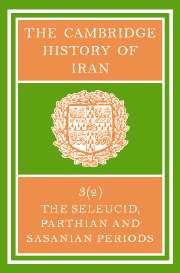Book contents
- Frontmatter
- PART 5 INSTITUTIONS
- PART 6 RELIGIOUS HISTORY
- 22 DEVELOPMENT OF RELIGIOUS THOUGHT
- 23 ZOROASTRIAN RELIGION
- 24 JEWS IN IRAN
- 25 CHRISTIANS IN IRAN
- 26 BUDDHISM AMONG IRANIAN PEOPLES
- 27(a) MANICHAEISM AND ITS IRANIAN BACKGROUND
- (b) MAZDAKISM
- PART 7 ART HISTORY
- PART 8 LANGUAGES AND LITERATURE
- PART 9 BIBLIOGRAPHY
- Bibliography
- Index
- Index of Greek words
- References
23 - ZOROASTRIAN RELIGION
from PART 6 - RELIGIOUS HISTORY
Published online by Cambridge University Press: 28 March 2008
- Frontmatter
- PART 5 INSTITUTIONS
- PART 6 RELIGIOUS HISTORY
- 22 DEVELOPMENT OF RELIGIOUS THOUGHT
- 23 ZOROASTRIAN RELIGION
- 24 JEWS IN IRAN
- 25 CHRISTIANS IN IRAN
- 26 BUDDHISM AMONG IRANIAN PEOPLES
- 27(a) MANICHAEISM AND ITS IRANIAN BACKGROUND
- (b) MAZDAKISM
- PART 7 ART HISTORY
- PART 8 LANGUAGES AND LITERATURE
- PART 9 BIBLIOGRAPHY
- Bibliography
- Index
- Index of Greek words
- References
Summary
IRANIAN RELIGION UNDER THE SELEUCIDS AND ARSACIDS
In consequence of Alexander's conquest, Iranian religious manifestations were almost completely submerged under the wave of Hellenism. Only a few facts bear witness to the survival of native religion during the period up to the national renaissance which was adumbrated in the 1st century b.c. and was to be characteristic of the Sasanian dynasty.
A comparison with the artistic development in the same periods is instructive. As shown by Schlumberger, three phases can be distinguished. The first one, represented on the island of Failaka in the Persian Gulf, at Ai Khanum on the Oxus, and elsewhere, is purely Hellenic. The second one, attested on Nimrud Dāgh, at Nisā and, in eastern Iran, at Kūh-i Khwāja, Khalchayan, and Surkh Kotal, offers a blend of Greek and Iranian elements. Only the third one sees a fusion of these heterogeneous elements into the unity of a new style, attested notably at Palmyra and Hatra, but which must have been born in the Parthian capital, Ctesiphon, and spread from there to the whole Arsacid empire, where it is notably attested at Tang-i Sarvak and Bard-i Nishānda.
Maybe the religion also yielded at first to the prestige of the Greco-Macedonian conquerors, at least where it had no deep roots. At Susa, for instance, which had been one of the capital cities of the Achaemenians but where the religion of Ahurā Mazdā was not autochthonous, the coinage of the Seleucid and Arsacid periods does not represent a single Iranian deity.
- Type
- Chapter
- Information
- The Cambridge History of IranSeleucid Parthian, pp. 866 - 908Publisher: Cambridge University PressPrint publication year: 1983
References
- 6
- Cited by



